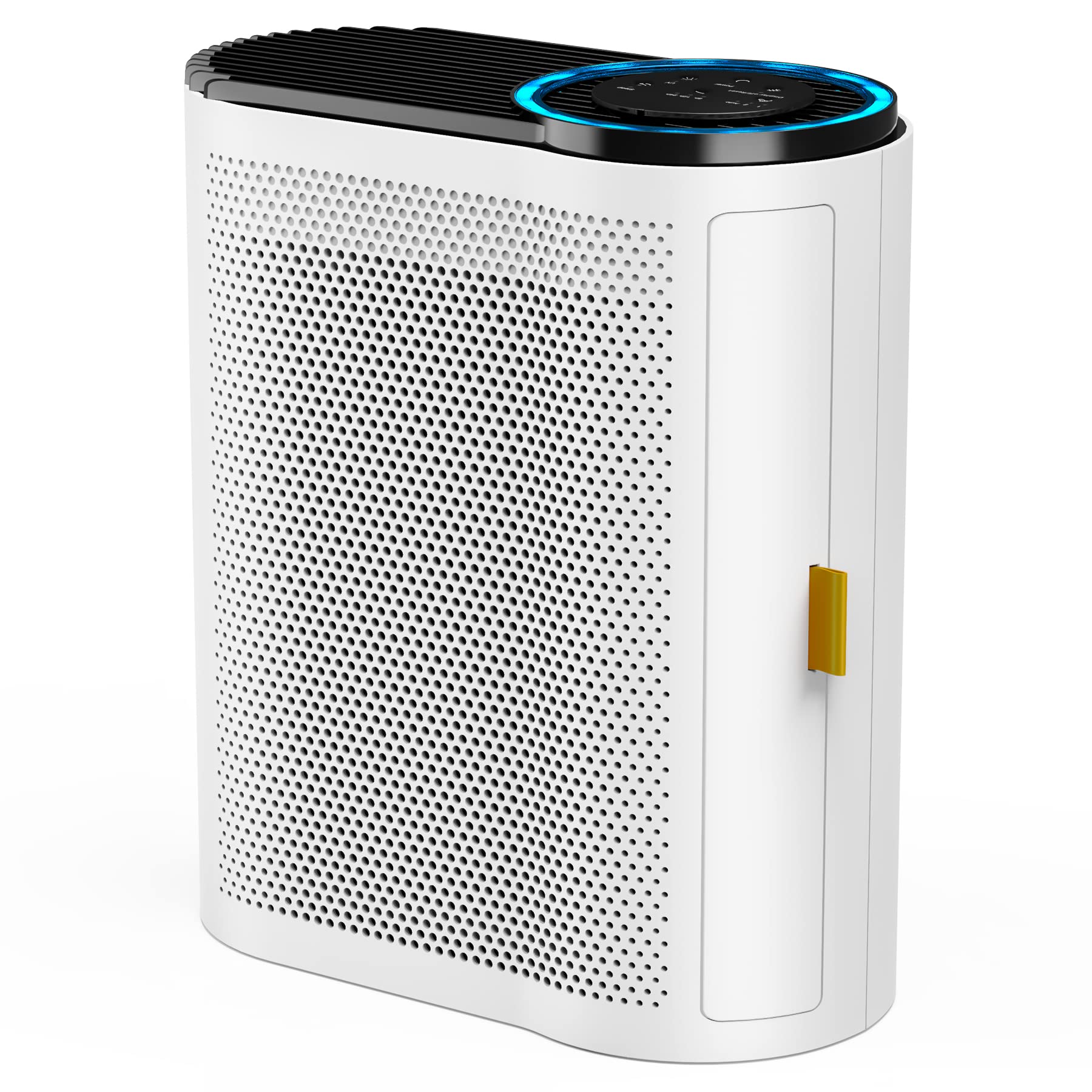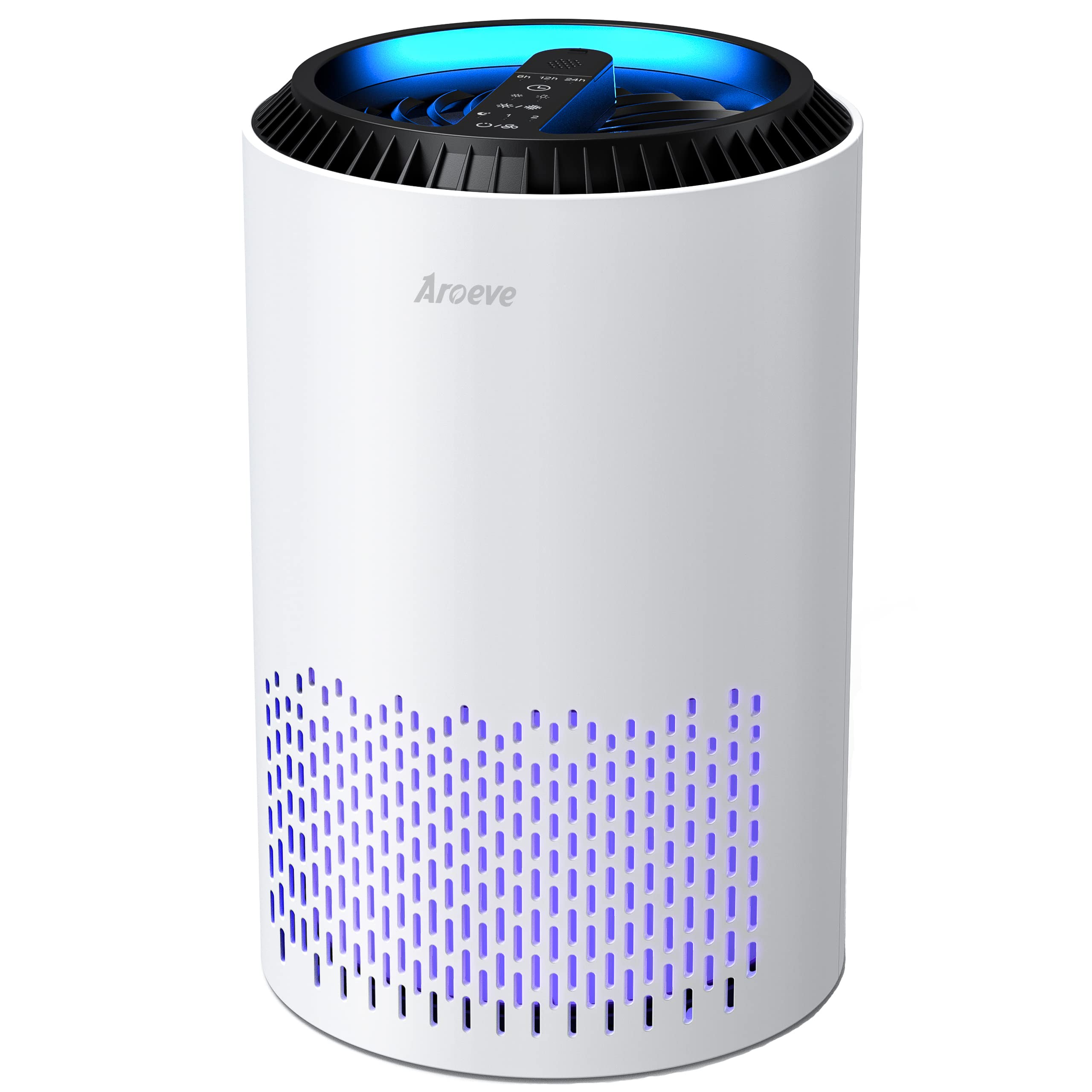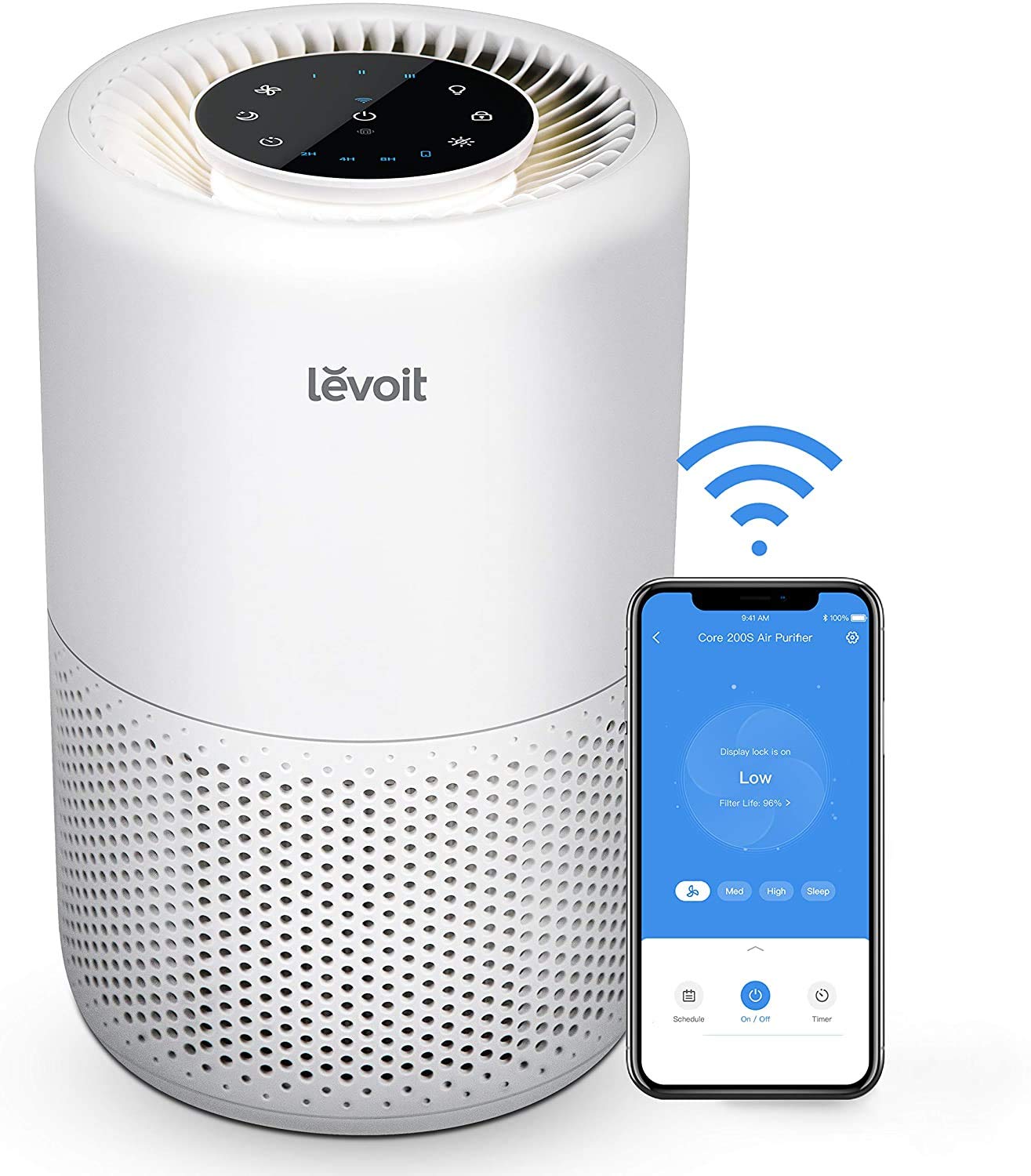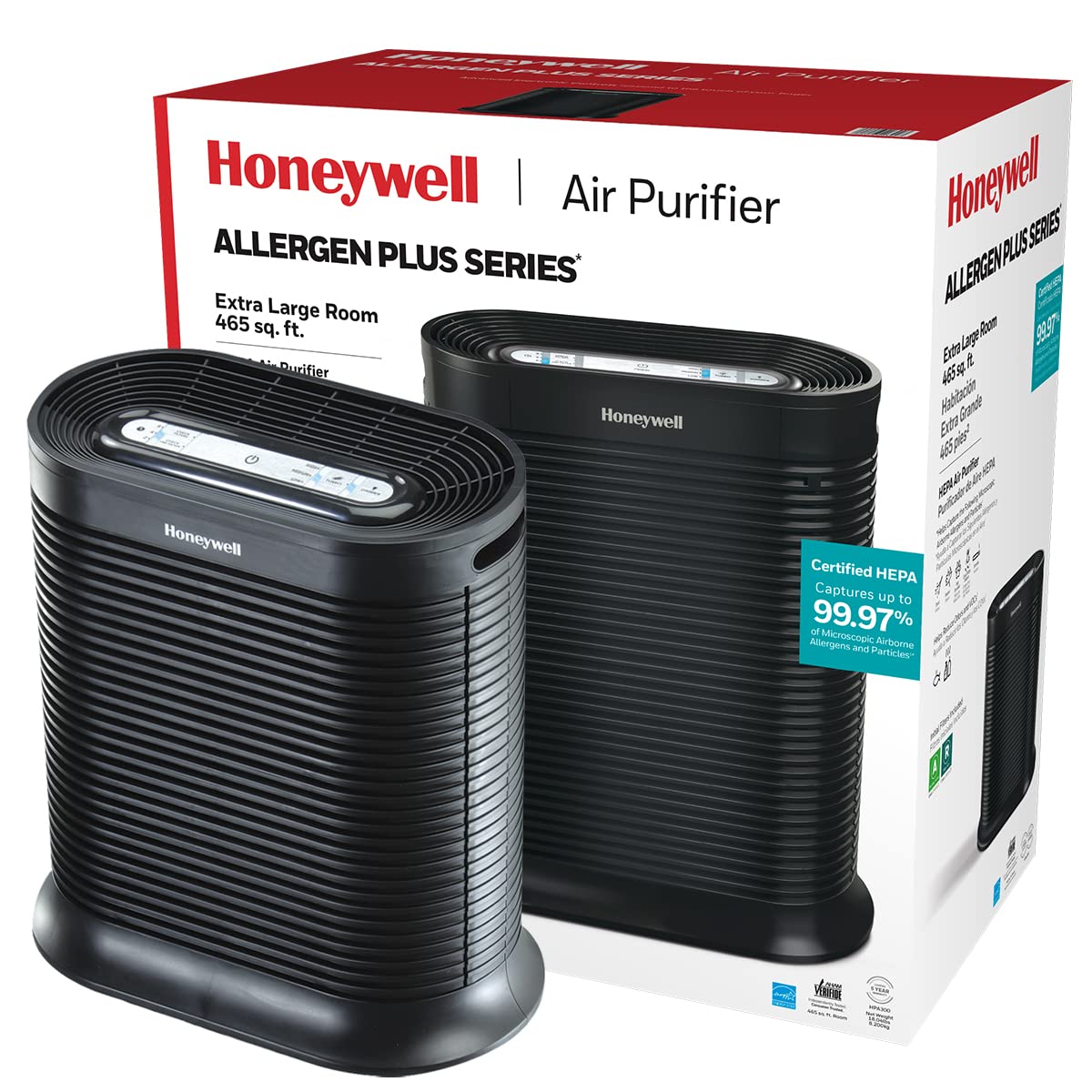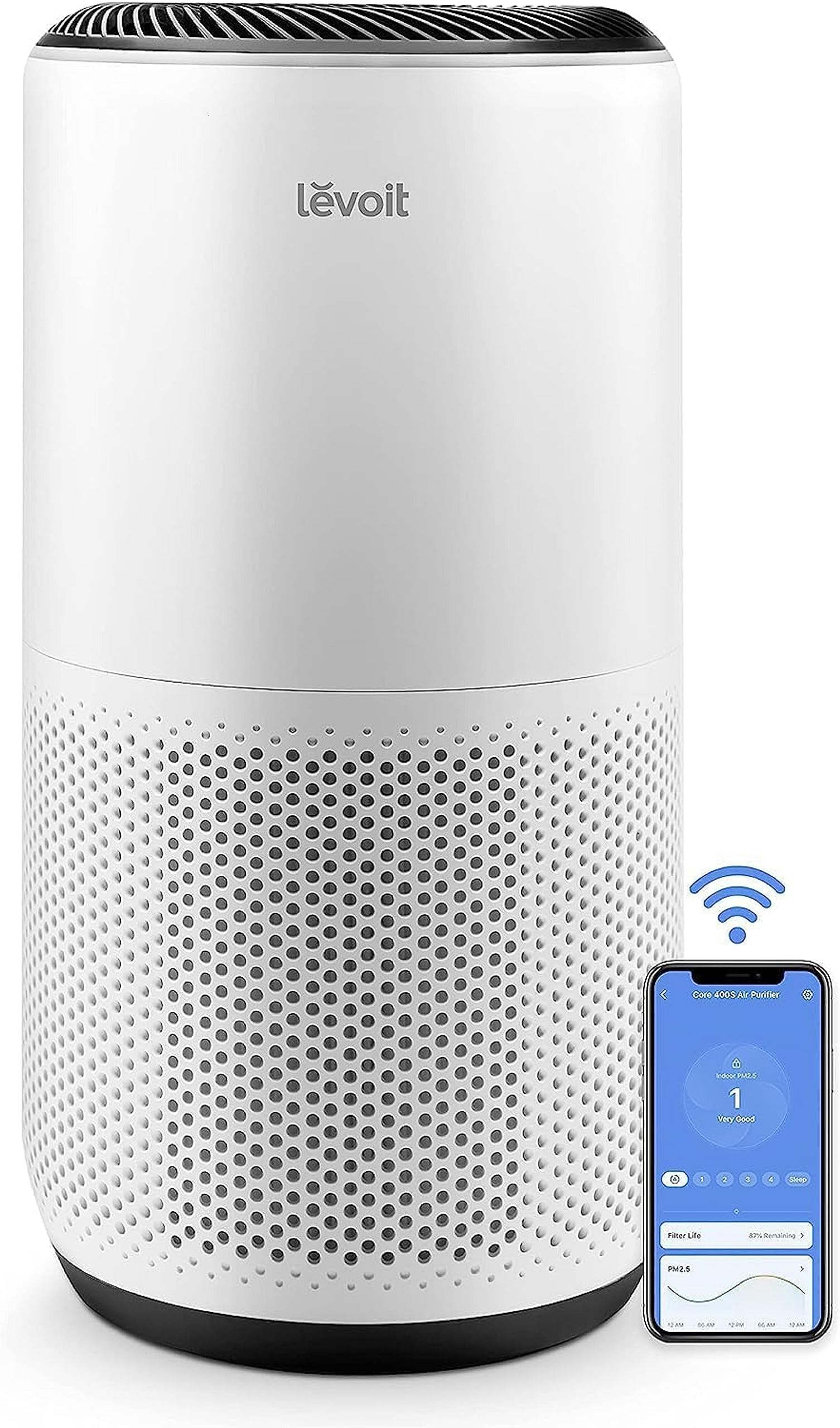Air Purifier Guides
When to Turn off Air Purifier

As I relax in my home, enjoying the fresh, purified air, it makes me ponder: when should I switch off my air purifier? Comprehending the best way to utilize this vital tool is key to preserving a wholesome atmosphere indoors.
In this article, I will delve into the factors affecting air quality, the ideal time to switch off the air purifier, and the health benefits and performance maintenance that come with it.
So, let’s dive in and unravel the mysteries of when to turn off the air purifier.
Key Takeaways
- Monitoring air pollution is crucial for determining when to turn off the air purifier
- An AQI below 50 generally indicates it is safe to turn off the purifier
- An AQI above 50 suggests keeping the purifier running for clean indoor air
- Regular monitoring and understanding air quality levels are essential for maintaining a pollutant-free environment
Understanding Air Quality Levels
To understand when to turn off your air purifier, you need to be aware of the current air quality levels. Monitoring air pollution is crucial in determining the effectiveness of your air purifier usage. By keeping track of the air quality index (AQI) in your area, you can make informed decisions about when to turn off your purifier.
When the air quality is good, with an AQI below 50, it is generally safe to turn off the purifier and let the natural ventilation do its job. However, if the AQI rises above 50, it is recommended to keep the purifier running to ensure clean and healthy air indoors.
Understanding the air quality levels is the first step in effective air purifier usage and maintaining a pollutant-free environment.
Transitioning into the next section, let’s now discuss the importance of monitoring indoor pollutants.
Monitoring Indoor Pollutants
Make sure you’re keeping an eye on the levels of indoor pollutants in your home. Indoor air pollution monitoring is crucial to ensure the air you breathe is clean and healthy.
By using effective air purifier usage, you can significantly reduce the presence of harmful pollutants. It’s important to understand that air purifiers work by filtering out pollutants from the air, but they do not eliminate them completely. Regular monitoring is necessary to determine when to turn off the air purifier.
One way to monitor indoor pollutants is by using air quality monitors. These devices measure and display the levels of pollutants in real-time, allowing you to take necessary actions to improve the air quality.
Monitoring indoor pollutants and using air purifiers effectively go hand in hand to create a healthier indoor environment for you and your family.
Ideal Time to Turn off the Air Purifier
When it’s time to give your air purifier a break, you should consider the ideal moment to stop using it. While air purifiers are incredibly useful in improving indoor air quality, they also have a lifespan that needs to be taken into account.
Here are a few things to keep in mind when deciding when to turn off your air purifier:
-
Nighttime use: If you use your air purifier primarily during the day, turning it off at night can help conserve its lifespan and reduce energy consumption.
-
Air quality: If the air in your home is consistently clean and free of pollutants, you may not need to run your air purifier continuously. Turning it off when the air is already clean can help extend its lifespan.
-
Maintenance: Regularly cleaning and replacing filters is essential for the proper functioning of your air purifier. Turning it off during maintenance can help ensure you perform these tasks correctly.
-
Noise and sleep: Some air purifiers can be noisy, which can disrupt your sleep. Turning it off at night can create a quieter sleeping environment.
Factors Affecting Air Quality
The factors that affect air quality can have a significant impact on the effectiveness of an air purifier. Understanding outdoor pollutants and the impact of air pollution on health is crucial in determining the effectiveness of an air purifier.
Outdoor pollutants such as particulate matter, volatile organic compounds (VOCs), and nitrogen dioxide can enter indoor spaces, compromising air quality. These pollutants can come from various sources like vehicle emissions, industrial activities, and burning of fossil fuels. Exposure to these pollutants has been linked to respiratory problems, cardiovascular diseases, and even cancer.
An air purifier with advanced filtration technologies can help remove these pollutants, improving indoor air quality and reducing the risk of health issues. However, it is important to note that air purifiers are more effective in smaller spaces, and factors like room size, pollution levels, and maintenance should be considered for optimal performance.
Determining Optimal Air Purifier Usage
To get the most out of your air purifier, you should consider factors such as room size, pollution levels, and maintenance. These factors play a crucial role in determining the optimal usage of your air purifier. Here are some key points to keep in mind:
-
Room size: Ensure that your air purifier is suitable for the size of the room you want to purify. Using an undersized purifier may not effectively clean the air, while an oversized one may consume excessive energy.
-
Pollution levels: If you live in an area with high pollution levels, you may need to run your air purifier for longer periods to maintain clean indoor air.
-
Maintenance: Regularly cleaning and replacing filters is essential for optimal performance and prolonging the lifespan of your air purifier.
-
Air purifier lifespan: While maintenance can extend the lifespan of your purifier, it is important to note that air purifiers have a finite lifespan, typically ranging from 5 to 10 years.
Considering these factors and performing regular maintenance will ensure that your air purifier functions optimally and lasts for years to come.
Now, let’s delve into nighttime air purifier considerations.
Nighttime Air Purifier Considerations
At night, it’s important to keep your air purifier running to maintain clean indoor air quality while you sleep. However, it’s crucial to consider the impact of nighttime noise levels on your sleep quality as well.
While air purifiers are designed to operate quietly, some models can still produce a low hum or white noise that may disturb light sleepers. If you are sensitive to noise, it may be best to choose a model specifically designed to operate silently or to use a noise machine to help mask any sounds.
Additionally, placing the air purifier away from your bed or using a timer to turn it off after a few hours can minimize any potential disruptions to your sleep. By finding the right balance between clean air and a peaceful sleep environment, you can enjoy the benefits of your air purifier without compromising your rest.
Seasonal Variations in Air Purifier Use
When it comes to seasonal variations in air purifier use, there are a few key points to consider.
Firstly, allergies and pollen can be a major concern during certain times of the year, and having an air purifier can help reduce the allergens in your home.
Secondly, humidity and mold can also become an issue, especially in humid climates or during the rainy season. An air purifier with a dehumidification feature can help maintain optimal indoor humidity levels and prevent the growth of mold.
Lastly, indoor air quality is important year-round, and using an air purifier can help remove pollutants and improve the overall air quality in your home.
Allergies and Pollen
If you’re suffering from allergies and pollen, keeping your air purifier on can help alleviate your symptoms. Pollen allergies can be particularly troublesome during certain seasons, such as spring and fall, when pollen levels are high.
Here are four reasons why having an air purifier can make a difference in managing seasonal allergies:
- Removes pollen particles from the air, reducing exposure and minimizing symptoms.
- Filters out other allergens like dust mites and pet dander, improving overall air quality.
- Helps relieve congestion and sneezing by reducing airborne irritants.
- Creates a clean and comfortable environment, allowing for better sleep and productivity.
Humidity and Mold
To prevent mold growth in your home, it’s important to keep the humidity levels in check. Mold thrives in damp environments, so controlling the moisture in your house is key to mold prevention.
High humidity levels provide the perfect conditions for mold spores to multiply and spread. To control humidity, make sure to use dehumidifiers in areas prone to excess moisture, such as your basement or bathroom.
Additionally, ensure proper ventilation by using exhaust fans in kitchens and bathrooms to remove steam and moisture from the air. Keep an eye out for signs of excessive moisture, such as condensation on windows or musty odors.
Indoor Air Quality
You can improve the indoor air quality in your home by regularly cleaning and dusting surfaces, as well as opening windows to allow fresh air to circulate. Understanding pollutants and taking steps to improve air quality is crucial for our overall well-being. Here are some key points to consider:
-
Reduce allergens: Dust mites, pet dander, and pollen can trigger allergies and asthma. Vacuum regularly and wash bedding in hot water to minimize these irritants.
-
Control humidity: High humidity levels can promote the growth of mold and mildew. Use a dehumidifier to maintain optimal humidity levels, between 30-50%.
-
Avoid toxic chemicals: Household products like cleaning sprays and air fresheners can release harmful chemicals into the air. Opt for natural alternatives or make your own cleaners using vinegar and baking soda.
-
Increase ventilation: Proper ventilation is essential to remove indoor air pollutants. Open windows when weather permits or use exhaust fans in kitchens and bathrooms.
Balancing Energy Consumption and Air Purification
When it comes to balancing energy consumption and air purification, there are several strategies that can help optimize efficiency.
One key strategy is to use the air purifier during specific times of the day when air pollution is at its peak, such as during rush hour or when outdoor activities are at their highest.
Energy-Saving Strategies
Using energy-saving strategies can help reduce the amount of electricity consumed by your air purifier. Here are some tips to help you save energy and reduce your environmental impact:
-
Use the air purifier only when needed: Turning it off when you’re not at home or when the air quality is already good can save energy.
-
Opt for energy-efficient models: Look for air purifiers with the ENERGY STAR label, as they are designed to consume less electricity.
-
Clean or replace filters regularly: Clogged filters make the air purifier work harder, leading to increased energy consumption.
-
Consider alternative purification methods: Some air purifiers use technologies like UV light or electrostatic precipitation, which can be more energy efficient than traditional filters.
Optimal Air Purification Time
When it comes to optimizing air purification, it’s important to consider the time of day. During the nighttime, the air quality tends to be better as there is less pollution and fewer allergens in the air. This makes it an ideal time to turn off your air purifier, especially if you want to save energy and reduce noise levels while you sleep.
However, even during the nighttime, it’s crucial to maintain your air purifier properly. Regular maintenance ensures that it operates efficiently and effectively. This includes cleaning or replacing the filters, removing any accumulated dust or debris, and checking for any signs of wear and tear.
Health Benefits of Turning off the Air Purifier
To maximize your health benefits, it’s important to turn off the air purifier when you don’t need it. While air purifiers are great for improving indoor air quality, keeping them on all the time may not be necessary and can have some drawbacks. Here are some reasons why turning off your air purifier can be beneficial:
-
Reduction in health risks: Continuous exposure to purified air can weaken our immune system, making us more susceptible to infections and allergies.
-
Cost analysis: Running an air purifier 24/7 can significantly increase electricity bills, especially if you have multiple units in your home.
-
Environmental impact: By turning off the air purifier when it’s not needed, you can save energy and reduce your carbon footprint.
-
Noise reduction: Some air purifiers can be noisy, especially at higher fan speeds. Turning them off when you don’t need them can create a more peaceful environment.
Maintaining Air Purifier Performance
If you neglect regular maintenance, your air purifier may not perform effectively.
One crucial aspect of maintaining air purifier performance is managing dust accumulation. Over time, dust particles can build up on the surface and inside the device, reducing its efficiency.
To prevent this, it is essential to clean the air purifier regularly. Wiping down the exterior with a damp cloth and using a soft brush to remove dust from the vents and grilles can help maintain optimal performance.
Another crucial maintenance task is filter replacement. Air purifiers have filters that trap pollutants and allergens, but these filters can become clogged over time. It is recommended to check the manufacturer’s instructions for the recommended filter replacement schedule and follow it diligently.
Signs That Indicate the Need to Turn off the Air Purifier
Excessively clean indoor air and unnecessary energy consumption are two issues that often go hand in hand.
When we strive for air that is too clean, we may end up using energy-intensive purification systems that constantly run, even when the air quality is already good. This not only wastes energy but also increases our carbon footprint, contributing to environmental degradation.
Excessively Clean Indoor Air
You should consider turning off your air purifier if the indoor air is excessively clean. While it may seem counterintuitive, there are certain situations where having pristine air can actually be detrimental to your health.
Here are a few reasons why excessively clean indoor air may pose health risks:
- Reduced exposure to natural bacteria and allergens can weaken the immune system.
- Lack of microbial diversity can lead to an increased risk of allergies and asthma.
- Overly sterile environments can hinder the development of a healthy microbiome.
- Excessive cleaning precautions may result in the use of harsh chemicals that can be harmful when inhaled.
Unnecessary Energy Consumption
To avoid unnecessary energy consumption, it’s important to consider the amount of power your air purifier uses when it’s running constantly. By reducing electricity usage, we can minimize our carbon footprint and contribute to a greener environment.
When choosing an air purifier, look for models with energy-saving features such as low power consumption and automatic shut-off timers. These features can help you save energy and reduce your electricity bills.
Additionally, consider the size of the room you are purifying and choose an air purifier that is appropriate for that space. A larger purifier may consume more energy than necessary for a small room.
Frequently Asked Questions
Can I Leave My Air Purifier on All the Time?
Yes, you can leave your air purifier on all the time. It helps maintain clean air and reduces allergens. Regular maintenance is important to ensure optimal performance and longevity of the device.
How Often Should I Clean or Replace the Filters in My Air Purifier?
I clean or replace the filters in my air purifier every 3-6 months. It’s important to keep the exterior clean as well to ensure optimal performance. Using an air purifier helps remove pollutants and allergens from the air, improving indoor air quality.
Are There Any Potential Health Risks Associated With Using an Air Purifier?
Using an air purifier can have potential side effects, such as dryness or irritation of the eyes and throat. To minimize these risks, proper air purifier maintenance, including regular filter cleaning or replacement, is crucial.
Can an Air Purifier Remove Odors From My Home?
Oh, an air purifier is a game-changer! It not only removes odors but also improves indoor air quality. Regular maintenance ensures peak performance. Enjoy the benefits of fresher air!
How Do I Know if My Air Purifier Is Working Properly?
To know if my air purifier is working properly, I can check if the filters are clean, listen for any unusual sounds, and observe if it effectively removes allergens and odors. Regular maintenance and troubleshooting are key.
Should I Turn off My Air Purifier If It Doesn’t Seem to Be Working Properly?
If your air purifier doesn’t seem to be working properly, refer to an air purifier effectiveness guide for troubleshooting tips. In some cases, turning it off temporarily may help reset the system. However, if the issue persists, consult the guide for further troubleshooting steps or consider seeking professional assistance.
Conclusion
In conclusion, knowing when to turn off your air purifier is crucial for maintaining a healthy and balanced indoor environment.
By understanding air quality levels, monitoring pollutants, and considering factors that affect air quality, you can determine the optimal usage of your air purifier.
It’s important to strike a balance between energy consumption and air purification, while also considering the health benefits of turning off the purifier.
By maintaining its performance and being mindful of signs indicating the need to turn it off, you can ensure a clean and refreshing atmosphere in your home.
In the dynamic world of air purifiers and clean air advocacy, Aire stands out as a beacon of knowledge and passion. As the Editor in Chief of Aero Guardians, Aire has been instrumental in shaping the platform’s voice and direction, ensuring that every piece of content resonates with clarity, authority, and authenticity.
Air Purifier Guides
The Ultimate Guide to Air Purifiers for People With Asthma
Learn how the right air purifier can transform your asthma management, but are you using it correctly for maximum effectiveness?
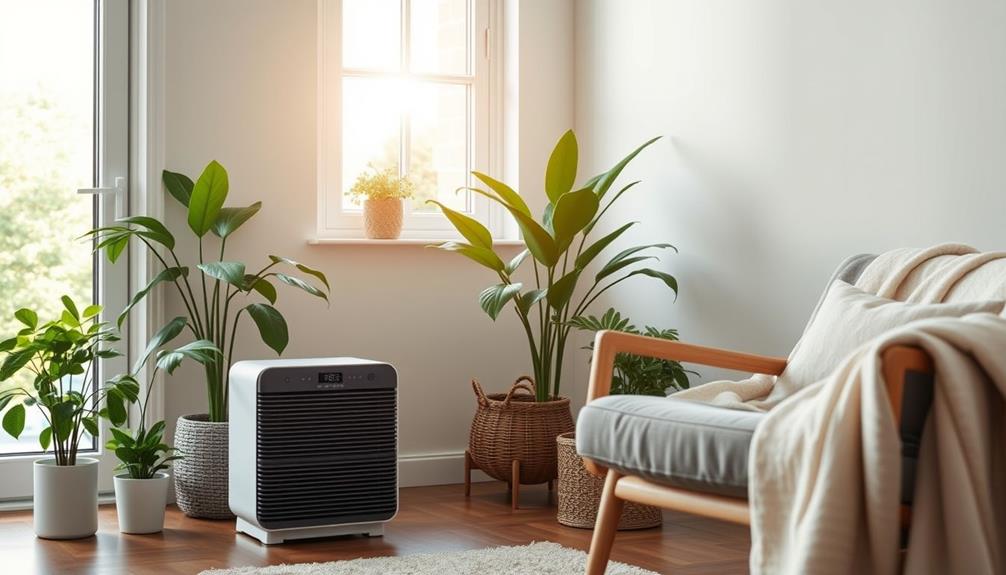
If you're managing asthma, having the right air purifier can make a big difference. Look for models with HEPA filters, which capture 99.97% of airborne allergens like pollen and dust mites. A Clean Air Delivery Rate (CADR) of at least 225 CFM is perfect for effective air cleaning. Position your purifier in key areas and keep it running continuously for maximum benefit. Remember to maintain the filters regularly for peak performance. With the right purifier and setup, you can greatly reduce asthma triggers at home. Explore further to uncover tips on choosing and enhancing your air purifier for better health.
Key Takeaways
- Air purifiers with true HEPA filters capture 99.97% of particles, reducing asthma symptoms effectively.
- Choose air purifiers with a CADR of at least 225 CFM for optimal air cleaning performance.
- Place air purifiers in key areas and maintain regular filter replacement for peak efficiency.
- Address common asthma triggers like dust mites, pollen, and mold alongside using air purifiers.
- Consider budget-friendly options and smart features to enhance asthma management through cleaner air.
Understanding Asthma and Air Purifiers
Asthma affects millions of people worldwide, making it essential to understand how air purifiers can help manage this condition. Air purifiers help you tackle indoor air quality issues by effectively removing airborne irritants that may trigger asthma symptoms. They work by filtering out allergens and pollutants, such as dust, pollen, and pet dander, which are common asthma triggers. Incorporating devices like ozone air purifiers can further enhance air quality by neutralizing persistent odors and allergens.
Most air purifiers utilize HEPA filters, known for their ability to capture 99.97% of particles as small as 0.3 microns. This means they can considerably clean the air in your home, reducing exposure to harmful air pollution.
By maintaining a cleaner indoor environment, air purifiers can lessen the frequency of asthma flare-ups and decrease your reliance on medications.
Regular use of air purifiers creates an effective air quality improvement strategy. You'll notice a difference in how you feel, as the removal of airborne irritants leads to a healthier living space.
Investing in an air purifier can be a considerable step toward managing your asthma and enhancing your overall well-being.
Choosing the Right Air Purifier
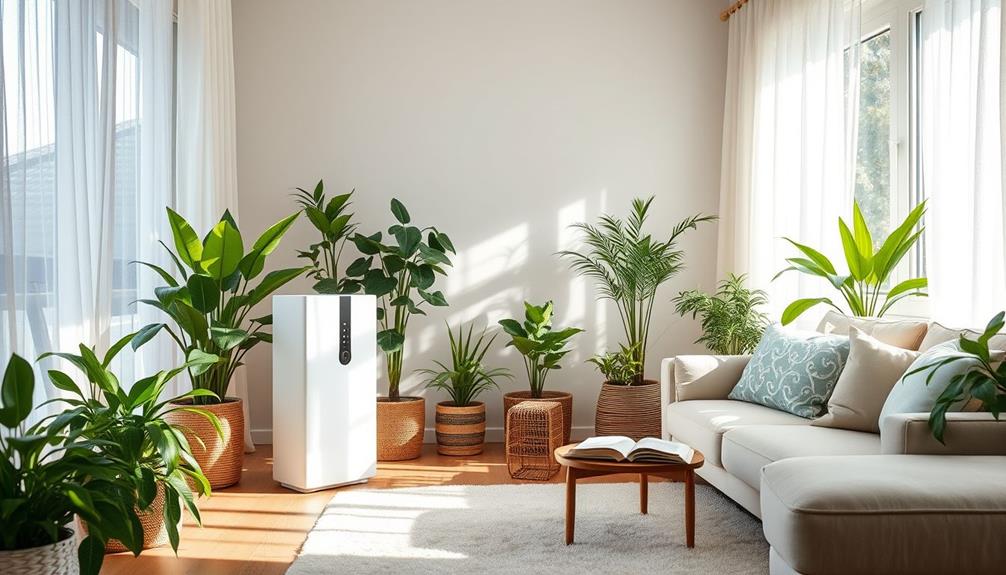
When managing asthma, selecting the right air purifier can greatly influence your indoor air quality and overall well-being. Start by looking for models equipped with True HEPA filters, which capture 99.97% of particles as small as 0.3 microns. This feature is essential for removing asthma-triggering allergens like pollen and dust mites from your space.
Additionally, adopting a healthy lifestyle can complement your efforts in minimizing asthma symptoms by ensuring a balanced diet and regular physical activity.
Next, consider the Clean Air Delivery Rate (CADR); a minimum score of 225 CFM is ideal for effective air cleaning in your home. It's also important to match the air purifier size to your room dimensions. A unit designed for 400 sq. ft. won't effectively purify larger areas.
Don't overlook the noise level, especially if you're using it in a bedroom. Quieter models below 55 dB are preferable to avoid disrupting your sleep.
Setting Up Your Air Purifier
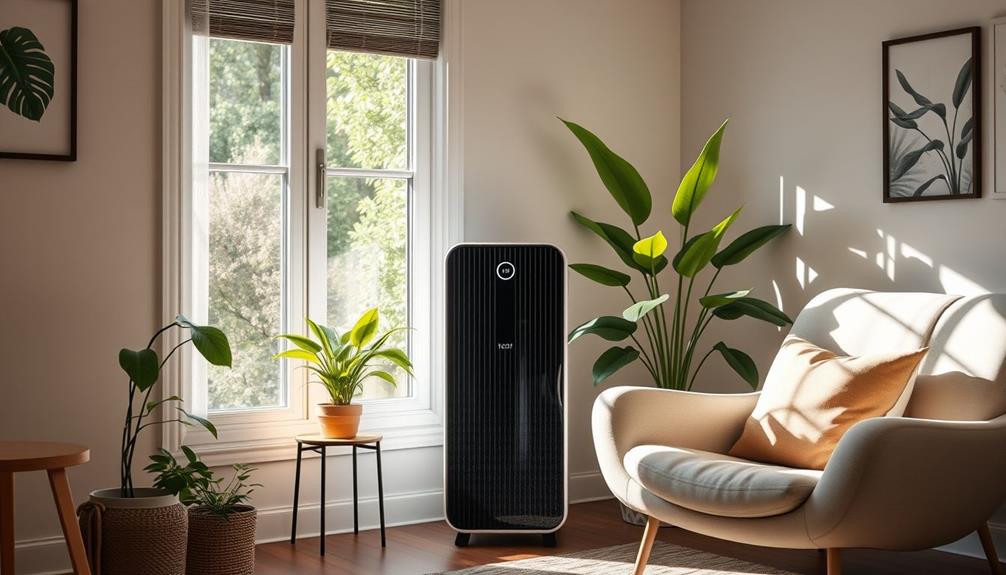
To maximize the effectiveness of your air purifier, strategically place it in key areas like bedrooms and living rooms where you spend the most time. These ideal locations enhance air quality and create a more comfortable environment.
Additionally, consider incorporating visible security measures to deter potential intruders, as home security systems also contribute to a safer indoor atmosphere. Make certain your air purifier isn't obstructed by furniture or walls; this allows for maximum airflow and efficiency.
If you're dealing with larger spaces, consider using multiple air purifiers to cover more area and improve overall air quality. This approach guarantees that every corner of your home benefits from cleaner air.
For the best results, operate your air purifier continuously and keep doors and windows closed to maintain a controlled environment free of outdoor pollutants.
Regular filter maintenance is vital for peak performance. Follow the manufacturer's guidelines for filter replacement, typically every 6-12 months. Keeping up with this maintenance guarantees that your air purifier operates at its best, effectively reducing allergens and irritants in your home.
Best Air Purifiers for Different Needs

Finding the right air purifier can make a significant difference in your indoor air quality, especially if you have specific needs or preferences. For effective asthma management, the Levoit EverestAir stands out as the best air purifier, boasting a clean air delivery rate (CADR) of 360 CFM, cleaning a 563 sq. ft. room in just 13 minutes.
Proper air quality is essential, particularly for individuals with asthma, as it can reduce triggers and improve breathing asthma exacerbations can result in phlegm production. If you need a quieter option, the Smart Air Blast Mini operates at a maximum noise level of 49 dB while covering 703 sq. ft. with a CADR of 435 CFM.
For larger spaces, consider the Levoit Core 600S, which combines smart features with a CADR of 410 CFM, effectively cleaning spaces in 15 minutes. If you're on a budget, the Levoit Core 400S is a budget-friendly option for small rooms up to 403 sq. ft. and offers a filter life of approximately 12 months.
Finally, if VOCs are a concern, the IQAir HealthPro Plus excels in eliminating these harmful particles in the air, cleaning up to 1125 sq. ft. in just 25 minutes.
Choose the right air purifier for asthma to guarantee cleaner air and better health.
Importance of HEPA Filters
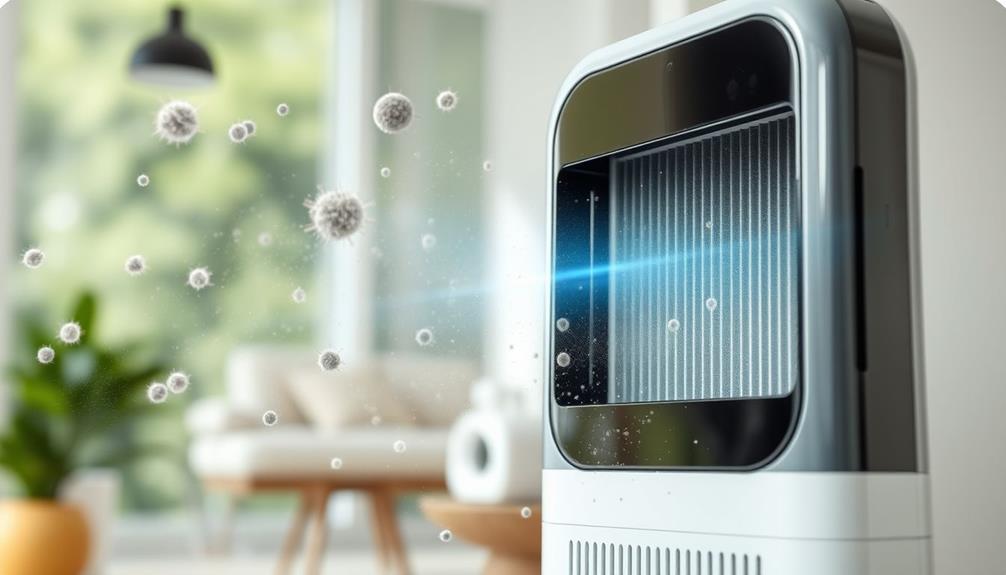
Choosing the right air purifier goes beyond just selecting a model; it's also about understanding the significance of the filters it uses. HEPA filters are crucial for anyone managing asthma. These filters capture 99.97% of airborne particles as small as 0.3 microns, effectively removing asthma-triggering allergens like pollen, dust mites, and pet dander.
Additionally, it's important to take into account how air quality impacts overall health and well-being, especially for those with respiratory conditions. Researching reputable brands can help you find reputable air purifier providers that prioritize effective filtration.
The efficiency of HEPA filters directly impacts your indoor air quality, as they greatly reduce levels of particulate matter (PM2.5) known to worsen respiratory symptoms. When choosing an air purifier, look for a model with a Clean Air Delivery Rate (CADR) score of at least 225 CFM. This guarantees rapid air purification, which is essential for keeping your environment safe from harmful particles.
Using True HEPA filtration not only helps in improving air quality but also contributes to fewer asthma flare-ups, enhancing your overall quality of life. Brands like Smart Air offer HEPA-only models that focus on performance and cost-effectiveness, making certain you get the best air cleaning solution tailored to your asthma-related needs.
Prioritizing HEPA filters is a smart step toward better health and comfort.
Common Asthma Triggers and Solutions
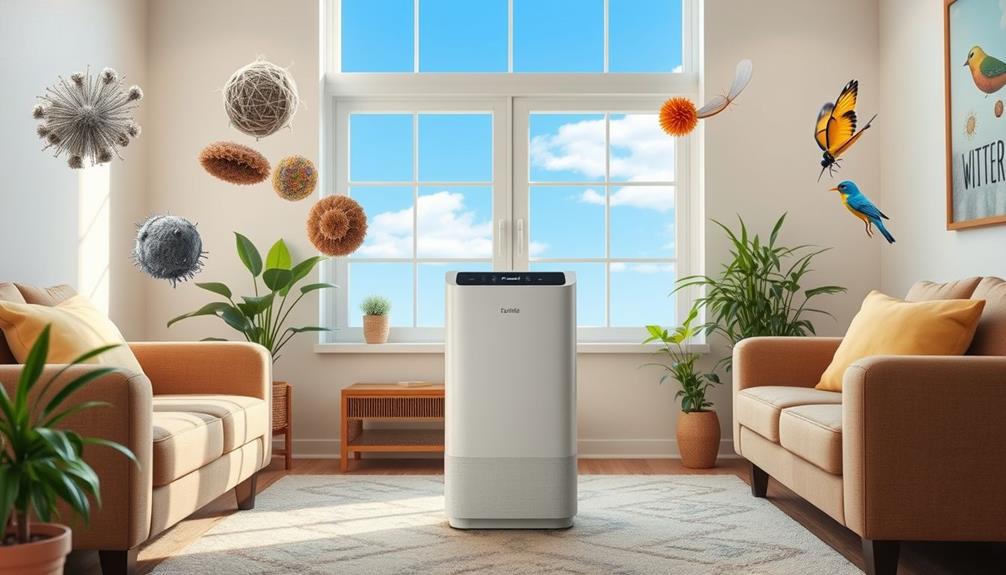
Asthma can be triggered by various common allergens and irritants found in our homes and environments. Dust mites are one of the main asthma triggers, thriving in bedding and carpets. To combat this, use allergen-proof covers and clean regularly.
Pollen from trees, grasses, and weeds can also worsen symptoms, so keep your windows closed during high pollen seasons and consider air purifiers with HEPA filters to improve indoor air quality. Understanding these triggers is essential for effective asthma management, similar to how preservation of traditions is important for cultural identity among communities.
Mold growth in damp areas is another notable trigger. You can prevent it by maintaining humidity levels below 50% and using dehumidifiers.
Pet dander is a common irritant as well; regular grooming of pets and utilizing HEPA air purifiers can help reduce dander in your home, benefiting your respiratory health.
Lastly, tobacco smoke is a major irritant for many asthma sufferers. Implementing indoor smoking bans can greatly enhance your indoor air quality and reduce asthma symptoms.
Reducing Asthma Triggers Beyond Air Purifiers

While air purifiers play a notable role in improving indoor air quality, there are several additional strategies to further reduce asthma triggers in your home.
Start by regularly vacuuming with HEPA filter vacuums and dusting with damp cloths. This helps effectively remove allergens like dust mites and pet dander, minimizing potential asthma triggers. Maintaining indoor humidity levels below 50% is vital, as higher humidity can promote mold and dust mites—common irritants for asthma sufferers. Consider using a dehumidifier to achieve this.
Additionally, invest in allergen-proof bedding covers to reduce exposure to dust mites. Implementing a strict no-smoking policy indoors is essential, as secondhand smoke can greatly irritate your respiratory system.
Combining these cleaning and humidity control measures with your air purifiers will create a thorough approach to managing asthma triggers.
| Strategy | Purpose | Benefits |
|---|---|---|
| Vacuum with HEPA filters | Remove allergens like dust mites | Reduces asthma triggers |
| Use dehumidifiers | Maintain humidity below 50% | Prevents mold growth |
| Allergen-proof bedding | Minimize exposure to dust mites | Eases asthma symptoms |
HouseFresh Resources and Credibility
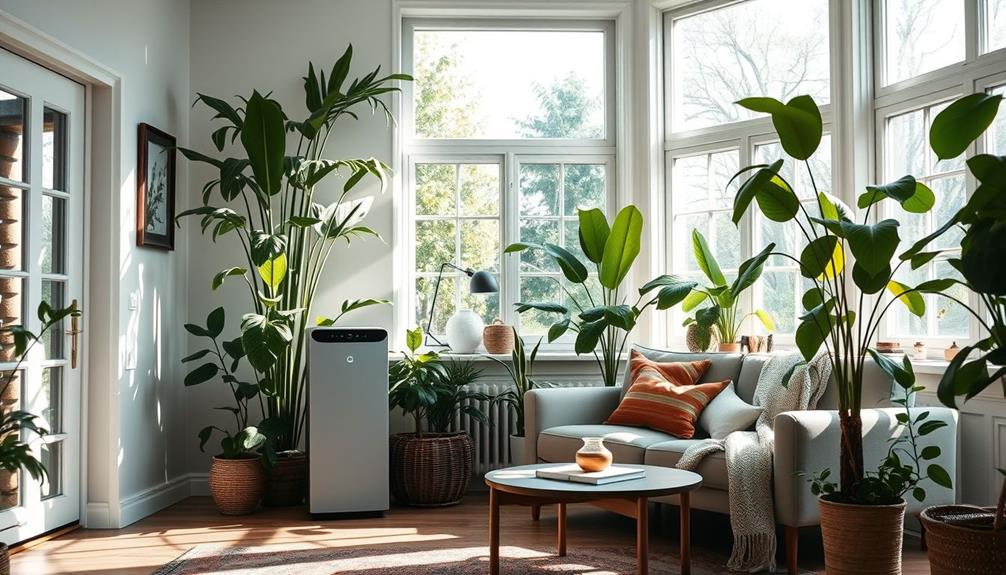
When it comes to finding reliable information about air purifiers, HouseFresh stands out as a credible resource. Since 2010, they've been reviewing air quality products, ensuring their evaluations are unbiased through real-world performance testing. They purchase products themselves, making their assessments trustworthy and relevant to your health needs.
Additionally, understanding the benefits of essential oils can complement your approach to improving air quality and promoting relaxation in your home environment, which is vital for individuals with asthma essential oils for relaxation.
HouseFresh emphasizes transparency by welcoming inquiries about their testing processes, so you can feel confident in their methodologies. Their website is filled with valuable resources, including articles that help you understand how different air purifiers and filters can reduce harmful particles in your environment, especially if you have asthma.
You'll also find tailored recommendations for budget-friendly options, ensuring you can find a solution that fits your needs without breaking the bank. Their commitment to consumer education shines through in detailed analyses and comparisons of air purifiers, specifically designed for individuals with respiratory conditions.
With HouseFresh, you can access the information you need to make informed choices about air purifiers that promote clean air and improve your overall health. Trust their expertise to guide you in selecting the right products for your asthma management.
Conclusion
To sum up, investing in the right air purifier can greatly improve your quality of life if you have asthma. Did you know that using a HEPA filter can reduce airborne allergens by up to 99.97%? That's a game changer for managing your symptoms. By choosing the right model and setting it up properly, you can create a healthier environment at home. Don't forget to tackle other asthma triggers too—it's all about making your space safe and comfortable.
In the dynamic world of air purifiers and clean air advocacy, Aire stands out as a beacon of knowledge and passion. As the Editor in Chief of Aero Guardians, Aire has been instrumental in shaping the platform’s voice and direction, ensuring that every piece of content resonates with clarity, authority, and authenticity.
Air Purifier Guides
Guide to Choosing the Right Replacement Filter for Your Air Purifier
Select the ideal replacement filter for your air purifier to ensure clean air; discover the essential factors you need to consider before making a choice.
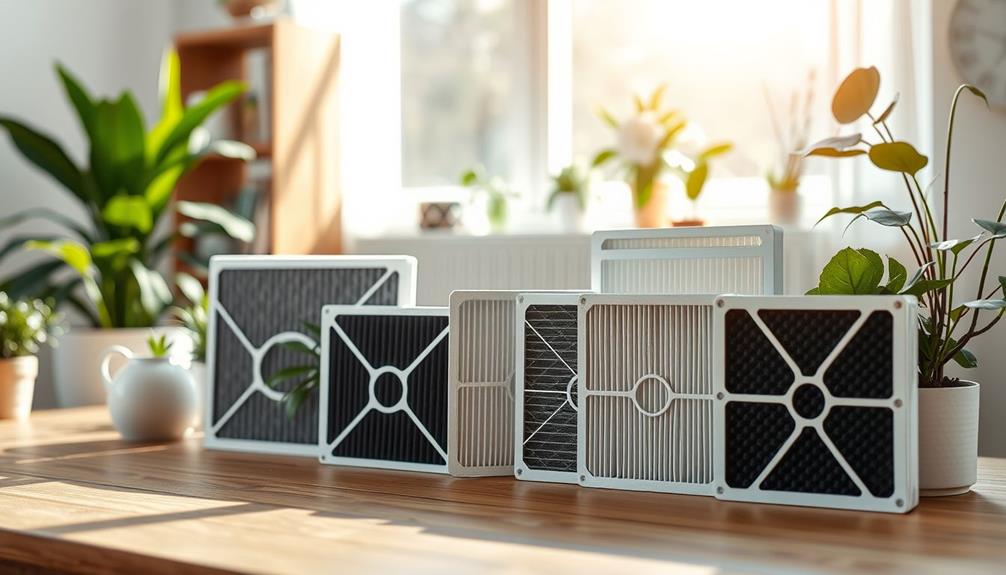
Choosing the right replacement filter for your air purifier is essential for keeping your indoor air clean and fresh. Start by identifying the type of contaminants you want to tackle, like allergens or odors. Look for HEPA filters for particles and activated carbon filters for smells. Always check the size and performance ratings, like MERV or FPR, to guarantee a proper fit and efficient operation. Consider your budget, as replacement costs can vary greatly. Regular maintenance is key, so keep an eye on filter indicators. There's a lot more you can explore to find the perfect filter for your needs.
Key Takeaways
- Identify the type of filter needed (HEPA, activated carbon, etc.) based on your specific air quality issues, such as allergens or odors.
- Ensure the replacement filter matches the correct dimensions by consulting manufacturer specifications to prevent air leaks.
- Monitor and replace filters regularly: HEPA filters every 6-12 months and activated carbon filters every 3 months for optimal performance.
- Consider the cost implications of replacement filters, balancing initial price with long-term maintenance expenses.
- Utilize accessories like pre-filters and filter subscription services to enhance efficiency and ensure timely replacements.
Understanding Air Purifier Filters
When it comes to air purifier filters, understanding their roles is key for maintaining a healthy indoor environment. Air purifier filters are essential for capturing airborne pollutants that can affect your indoor air quality.
HEPA filters are particularly important, as they're designed to capture 99.97% of particles as small as 0.3 microns. This makes them highly effective against allergens, providing relief for those with allergies or asthma. Additionally, many air purifiers, such as Levoit models, feature multiple filtration stages that enhance overall air cleaning efficiency.
On the other hand, activated carbon filters excel at trapping odors and volatile organic compounds (VOCs), which can be detrimental to your health. However, these filters require more frequent replacement due to their limited absorption capacity.
To enhance the efficiency of your air purifier, some models include pre-filters. These capture larger particles like hair and dust, prolonging the lifespan of the main filters.
To choose the right filter, you need to take into account your specific air quality concerns. Are you primarily dealing with allergens or unpleasant odors? By understanding the distinct roles of HEPA and activated carbon filters, you can effectively select the appropriate filter type to improve your indoor air quality.
Types of Air Filters

What types of air filters are available to enhance your indoor air quality? Choosing the right filter can make a considerable difference in how clean and healthy your air is. Here's a quick overview of some popular filter types:
– HEPA Filters: These are excellent for capturing 99.97% of particles as small as 0.3 microns, making them ideal for allergens like dust, pollen, and pet dander.
Additionally, using essential oils for relaxation can complement your air purification efforts by improving overall well-being and reducing stress in your indoor environment.
- Activated Carbon Filters: If odors and volatile organic compounds (VOCs) are your concern, these filters excel at trapping unwanted smells from pets, cooking, and smoke.
- UV-C Filters: Utilizing ultraviolet light, these filters neutralize airborne pathogens like viruses and bacteria, giving your air purifying system a germicidal boost.
- Ionic Filters: These emit charged ions that attract and neutralize airborne pollutants. However, be cautious, as they can produce ozone in high concentrations.
- Pre-Filters: Acting as the first line of defense, pre-filters capture larger particles like hair and lint, which helps extend the life of your main filters.
Selecting the right type for your needs can considerably improve your indoor air quality.
Air Filter Performance Ratings
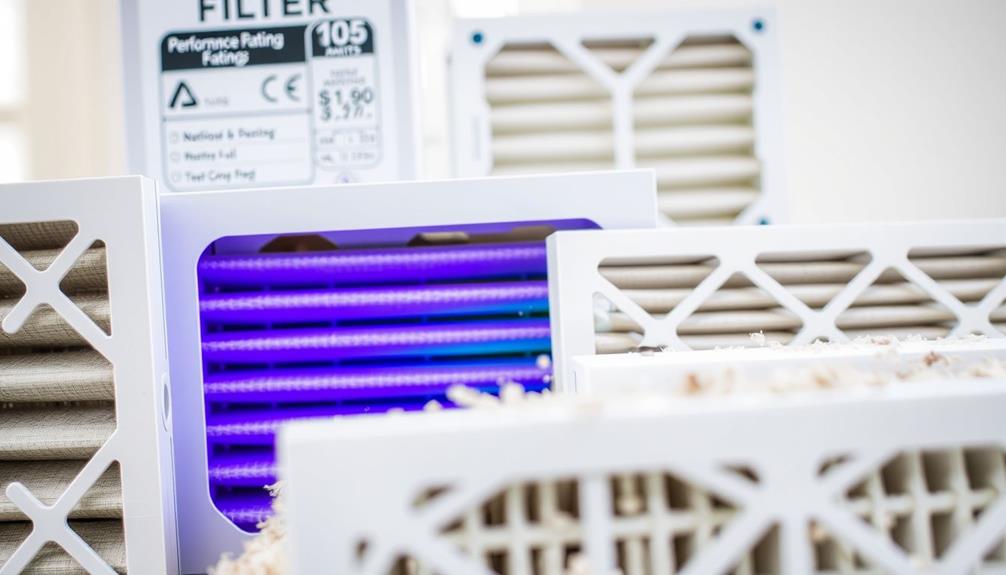
Understanding air filter performance ratings is vital for selecting the most effective option for your needs. Two common systems used to evaluate air filters are the Minimum Efficiency Reporting Value (MERV) and the Home Depot Air Filter Performance Rating (FPR).
MERV ratings range from 1 to 20, and for residential use, a MERV of 6 or higher is recommended, with MERV 8 being quite standard. Additionally, just as cats have specific preferences for their environment, air quality can considerably impact overall well-being, making it essential to choose the right filter research shows cats can recognize their owner's voice and scent.
On the other hand, the FPR system ranks filters from 1 to 12 based on their particle capture ability, considering large particle capture (60%), small particle capture (30%), and weight gain (10%) to determine overall filter effectiveness. Remarkably, an FPR of 10 is comparable to a MERV 20 rating, indicating superior filtration performance.
When choosing a filter, remember that an FPR of 1 doesn't equal a MERV rating of 1; these systems measure filter performance differently.
Evaluating Filter Size
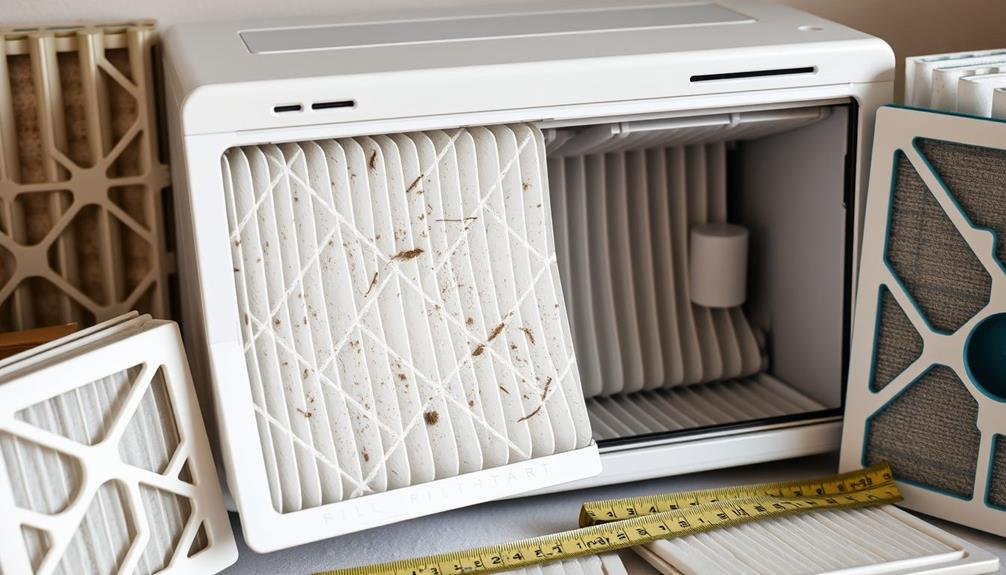
When you're choosing a replacement filter, understanding the dimensions is key.
It's important to take into account the specific requirements of your air purifier model, as different units may have unique filter specifications.
You need to make certain you're measuring both the nominal and actual sizes to guarantee a proper fit.
A filter that doesn't fit right can compromise your air purifier's efficiency, so getting it right is essential.
For additional insights on selecting the right service for your needs, check out key factors in choosing a home cleaning service.
Understanding Filter Dimensions
Choosing the right filter size for your air purifier is essential for maintaining its efficiency and effectiveness. Understanding filter dimensions can help you make an informed choice. Filters are measured in nominal sizes, which are approximate, and actual sizes, which are exact. It's important to verify both when selecting a replacement filter.
Additionally, a well-maintained air purifier can contribute to the overall safety and comfort of your home, similar to the benefits of having a reliable home security system.
Here are a few tips to keep in mind:
- Know common nominal sizes: Popular dimensions include 16 x 25 x 1, 20 x 25 x 1, and 20 x 20 x 1.
- Check thicknesses: Filters come in varying thicknesses, ranging from less than 1 inch to 6 inches.
- Refer to manufacturer's specifications: Always consult the specifications for your air purifier to confirm you're getting the correct filter dimensions.
A proper fit is essential, as incorrect filter sizes can lead to inefficiency and reduced filtration performance. If your air purifier requires a unique size, custom filters are available, and subscription services can help guarantee you receive the right filter dimensions on a regular basis.
Importance of Proper Fit
Proper fit is vital for guaranteeing your air purifier operates at peak efficiency. When you choose replacement filters, you need to focus on matching the exact size required by your air purifier model. Filters are measured in both nominal and actual sizes, so it's important to verify specifications to achieve ideal performance.
Common sizes like 16 x 25 x 1 or 20 x 20 x 1 might be standard, but using an improperly sized filter can result in air leaks and allow unfiltered air to circulate throughout your home. Additionally, selecting the right filter can enhance the overall air quality in your home, similar to how garage door openers improve security and convenience.
If your air purifier requires a unique size, don't worry—custom size filters are available. These options guarantee that even less common dimensions can secure a proper fit, allowing your unit to function effectively.
To make your life easier, consider subscribing to a service that delivers replacement filters automatically. This way, you can consistently maintain the correct size and type, reducing the risk of using the wrong filters in your air purifier.
Measuring Nominal Vs. Actual
Understanding the difference between nominal and actual filter sizes is vital for selecting the right replacement for your air purifier. Nominal sizes are the approximate dimensions you'll often see, like 16 x 25 x 1 or 20 x 20 x 1. However, actual sizes can vary slightly from these figures, which can lead to issues if you're not careful.
Selecting the correct filter size is critical for maximum air quality, similar to how hydration strategies are important for metabolism during physical activities.
Here's what you need to keep in mind when evaluating air filters:
- Fit Matters: An improperly fitting filter can create gaps, reducing the filtration effectiveness.
- Check Specifications: Always refer to the manufacturer's guidance on nominal versus actual sizes.
- Measure Twice: Use precise measurements to confirm you choose the right replacement filter.
Getting the right size is essential for maintaining airflow and making sure your purifier operates effectively. A mismatch hinders filtration and can make your air quality worse instead of better.
Specific Air Quality Needs
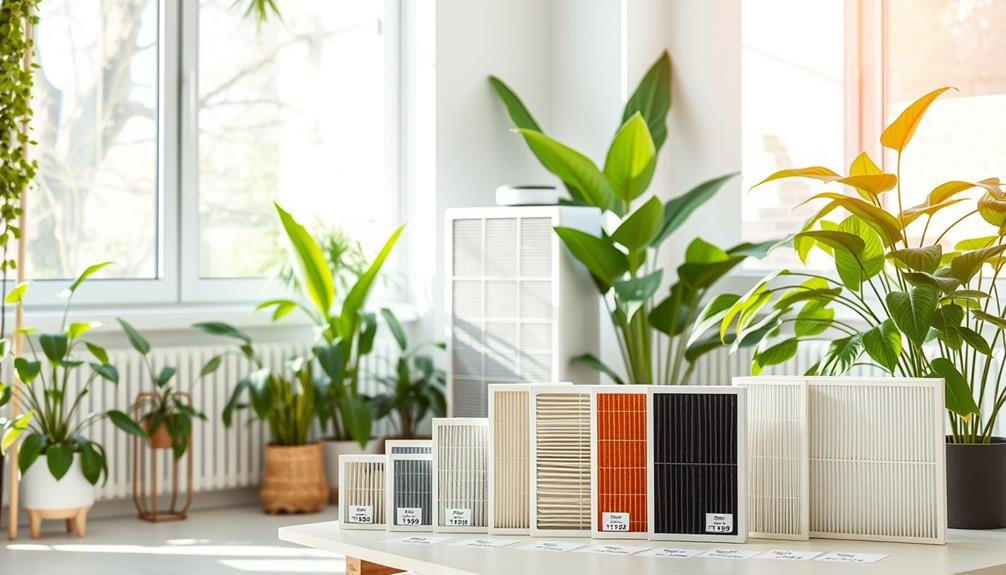
When you think about your air quality needs, consider what specific issues you're facing, like allergies or unpleasant odors.
For pet owners, understanding the impact of dog health and nutrition can also be essential, as pet dander can contribute to allergies.
If you're dealing with allergens, HEPA filters are your best bet for catching tiny particles.
For pet owners or those sensitive to cooking smells, activated carbon filters can tackle those odors effectively, ensuring your home feels fresh and clean.
Allergies and Asthma Management
For those managing allergies and asthma, selecting the right air purifier filter is vital in maintaining a healthy indoor environment. HEPA filters play an essential role, capturing 99.97% of particles as small as 0.3 microns, which includes common allergens like dust mites, pollen, and pet dander.
Additionally, guaranteeing proper ventilation and minimizing indoor pollutants can further enhance air quality, especially in homes with plumbing issues that may contribute to mold growth. Regularly replacing air purifier filters, typically every 6-12 months, can notably reduce airborne irritants and improve indoor air quality, especially in environments where clogging remedies might be necessary to mitigate moisture issues.
When choosing replacement filters, keep these key points in mind:
- Check the CADR rating: A higher Clean Air Delivery Rate indicates more effective removal of allergens and pollutants.
- Consider combination filters: Using HEPA filters alongside activated carbon filters can help eliminate odors that might trigger allergic reactions or asthma symptoms.
- Monitor air quality: Adjusting your air purifier settings based on quality sensors guarantees peak performance against fluctuating allergen levels.
Odor Control Requirements
Air quality isn't just about filtering out allergens; effective odor control is equally important, especially in homes where cooking, pets, or smoke contribute to unpleasant smells.
If you're dealing with strong odors, activated carbon filters are vital. These filters are specifically designed to trap odors, making them a must-have for households with sensitive residents or those who suffer from allergies or respiratory conditions.
Incorporating a holistic lifestyle approach can also help improve overall well-being, which indirectly contributes to a fresher indoor environment, as discussed in menopause management.
To achieve ideal odor control, you should look for air purifiers that combine HEPA filters with activated carbon filters. This combination not only captures airborne particles but also reduces unpleasant smells, greatly improving your indoor air quality.
Keep in mind that not all air purifiers are created equal when it comes to odor removal, so choose one that fits your specific needs.
Regularly replacing your activated carbon filters is essential, typically every 3 to 6 months, to guarantee they remain effective in absorbing odors.
Maintenance and Replacement

Maintaining your air purifier is crucial for guaranteeing it operates at peak efficiency, and regular filter replacement plays a significant role in that. HEPA filters typically need replacement every 6-12 months, while activated carbon filters may require changes every 3 months due to their odor absorption capabilities.
To keep your air purifier functioning at its best, consider these maintenance tips:
- Check the manufacturer's recommendations for your specific model to know the right maintenance schedules.
- Pay attention to filter service indicator lights that alert you when it's time to replace or clean the filters.
- Clean washable filters regularly to prolong their lifespan and enhance air purification effectiveness.
Investing in high-quality filters not only improves performance but can also reduce the frequency and cost of replacements over time.
Remember, proper maintenance is crucial. By staying on top of your air purifier's filters, you can guarantee a healthier indoor environment and better air quality.
Don't neglect this aspect of your home care routine; your lungs will thank you!
Cost Considerations
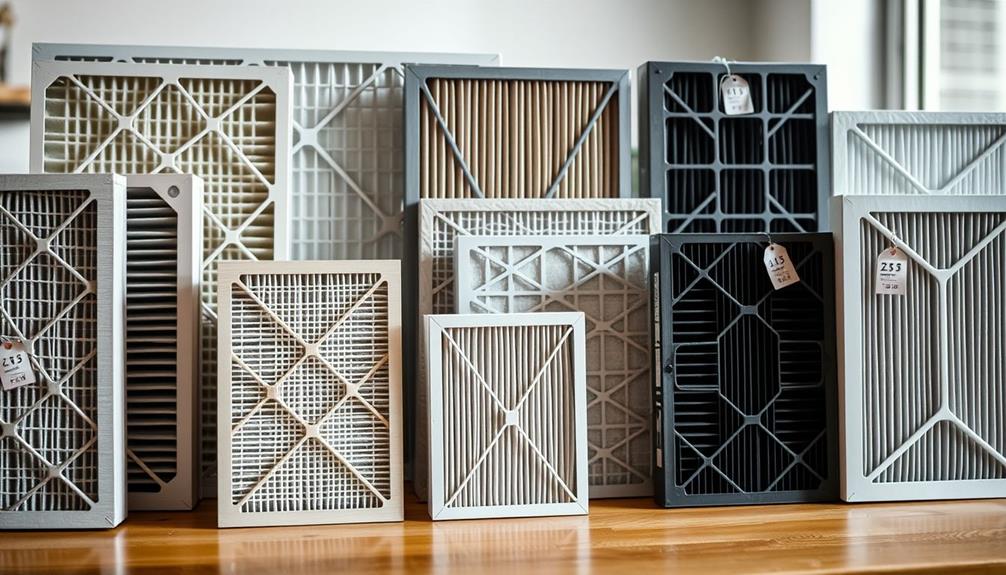
Understanding the costs associated with replacement filters is essential for effective air purifier maintenance. Replacement filter costs can vary widely, typically ranging from $20 to over $200, depending on the type and brand.
HEPA filters generally need replacement every 6 to 12 months, while activated carbon filters require changing every 3 months due to odor absorption.
When budgeting for filter replacement, consider the ongoing costs, as these can accumulate and impact your overall affordability for maintaining an air purifier. It's vital to factor in these maintenance expenses when selecting your model.
Some air purifiers may have lower upfront costs but could lead to higher ongoing expenses due to frequent filter changes.
Additionally, investing in an Energy Star certified air purifier can help reduce long-term energy costs, as these models are at least 40% more energy-efficient than standard ones. This can offset some of the filter replacement expenses you might face.
Ultimately, understanding these cost considerations will help you make a more informed decision, ensuring you choose an air purifier that fits both your needs and your budget.
Accessories for Air Filters
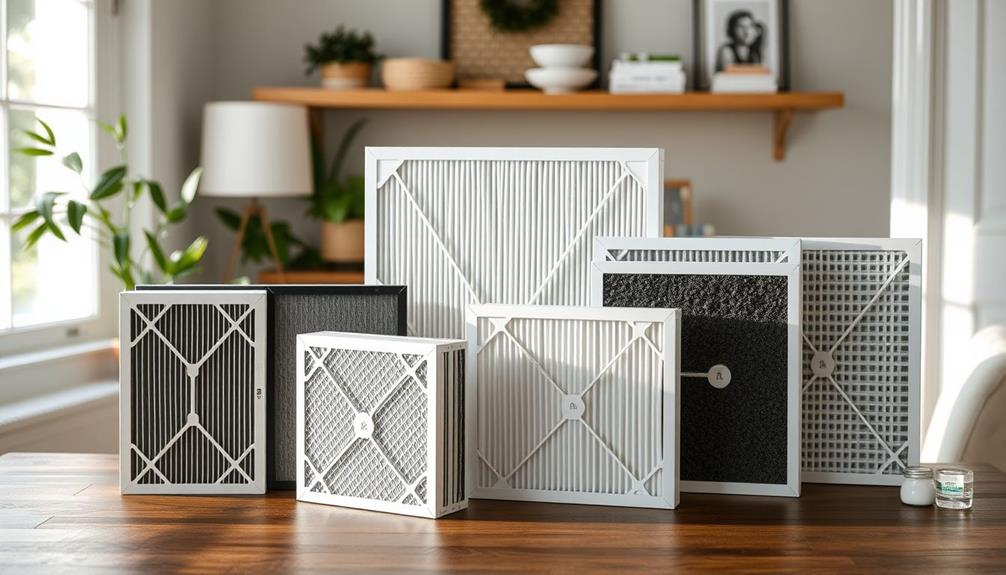
When it comes to air filters, various accessories can greatly enhance your air purifier's performance.
From pre-filters that catch larger particles to maintenance tools that help keep everything running smoothly, these additions can make a real difference.
Plus, understanding the benefits of each accessory guarantees you get the most out of your investment in clean air.
Types of Accessories
Choosing the right accessories for your air purifier can greatly enhance its performance and lifespan. Some essential accessories can help you maintain cleaner air and reduce costs in the long run. Here are a few you should consider:
- Pre-filters: These capture larger particles like hair and dust, extending the life of your main filter and improving efficiency.
- Activated carbon filters: Perfect for eliminating odors from pets, cooking, and smoke, these filters considerably enhance indoor air quality.
- Replacement filter indicator: This handy feature alerts you when it's time to change filters, guaranteeing your purifier runs at peak performance.
You might also want to explore washable pre-filters, which can be cleaned and reused, making your air purification practices more sustainable and economical.
Additionally, consider filter subscription services that automatically deliver replacement filters to your doorstep at scheduled intervals. This way, you won't have to worry about remembering to order new filters, and you'll assure timely changes for better air quality.
Maintenance Tools
Maintaining your air filter is essential for guaranteeing it operates efficiently and effectively. To achieve this, consider investing in several maintenance tools that can enhance your air purifier's performance and prolong its lifespan.
For instance, vacuum attachments and soft brushes can effectively clean pre-filters by removing larger particles before they reach the main filter, ultimately improving air quality.
Don't overlook filter replacement reminder apps; they can notify you when it's time to change your filters, guaranteeing your air purifier continues to deliver clean air. If you have washable filters, air filter cleaning kits with specialized solutions can help maintain their efficiency over time.
Additionally, using replacement filter storage bags protects new filters from dust and damage before installation, maintaining their quality until you're ready to use them.
Finally, consider monitoring tools like air quality sensors that provide real-time data on indoor air pollution. This information can help you decide when maintenance or filter replacements are necessary, guaranteeing your air purifier operates at its best.
Benefits of Accessories
Using the right accessories can greatly enhance your air purifier's performance and longevity. By integrating accessories like pre-filters, you can capture larger particles such as hair and lint, which prolongs the life of your main filters and boosts overall filtration efficiency.
Here are some key benefits of using accessories with your air purifier:
- Filter Service Indicator Light: This handy accessory reminds you when it's time to replace or clean your filters, ensuring peak performance at all times.
- Air Quality Sensors: These sensors automatically adjust purification levels based on detected pollution, helping you maintain consistent air quality effortlessly.
- Washable Pre-Filters: Not only do these reduce waste, but they also save you money on frequent filter replacements.
Additionally, accessories like filter racks and storage bags help keep your replacement filters organized and clean, so they're ready for use when you need them.
Common Air Purifier Brands
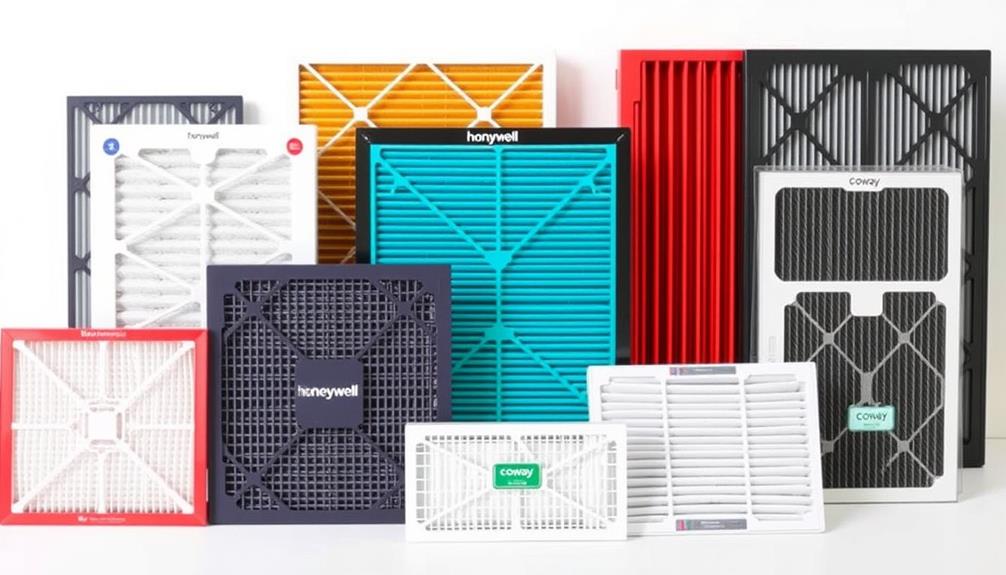
When it comes to selecting an air purifier, several well-known brands stand out in the market. Understanding these brands can enhance your Air Purifier Buying experience and help you make informed choices. Here are some common air purifier brands that you should consider:
| Brand | Price Range | Notable Features |
|---|---|---|
| Alen Corporation | $200 – $800 | True HEPA filters |
| Blueair | $120 – $1,000 | High Air Delivery Rate (CADR) |
| Dyson | $300 – $700 | Advanced technology and design |
| GermGuardian | $60 – $1,000 | Affordability and effectiveness |
| Honeywell | $70 – $500 | Wide availability |
Brands like Coway Airmega and LG are also notable for their innovative technology and efficient solutions. Each of these brands offers a variety of models tailored to different needs, emphasizing features like True HEPA filtration and high CADR ratings. When you explore these options, you can find the perfect air purifier to improve your indoor air quality.
Tips for Optimal Use

To get the most out of your air purifier, regularly checking the filter status indicator light is essential. Most filters should be replaced every 6-12 months for peak performance. Choosing the right replacement filters compatible with your model guarantees that your purifier maintains its cleaning efficiency.
Here are some tips to enhance your air purifier's effectiveness:
- Use washable pre-filters to capture larger particles, which prolongs the life of your primary filters and reduces maintenance costs.
- Strategically place your air purifier in frequently used rooms, avoiding any obstructions that could hinder airflow.
- Monitor your air quality regularly and adjust the speed settings based on pollution levels. Use higher speeds when you're not around to keep the environment quiet.
Conclusion
In the quest for cleaner air, choosing the right replacement filter can feel like maneuvering through a labyrinth. By understanding your specific needs and the types of filters available, you're not just picking a product; you're investing in your health. Remember, the right filter can be your shield against allergens and pollutants, much like a knight guarding a castle. So, arm yourself with knowledge, keep those filters fresh, and breathe easy knowing you've made the right choice.
In the dynamic world of air purifiers and clean air advocacy, Aire stands out as a beacon of knowledge and passion. As the Editor in Chief of Aero Guardians, Aire has been instrumental in shaping the platform’s voice and direction, ensuring that every piece of content resonates with clarity, authority, and authenticity.
Air Purifier Guides
Choosing an Air Purifier for Your Office or Workspace
Properly selecting an air purifier can transform your office environment, but are you aware of the key factors to consider?
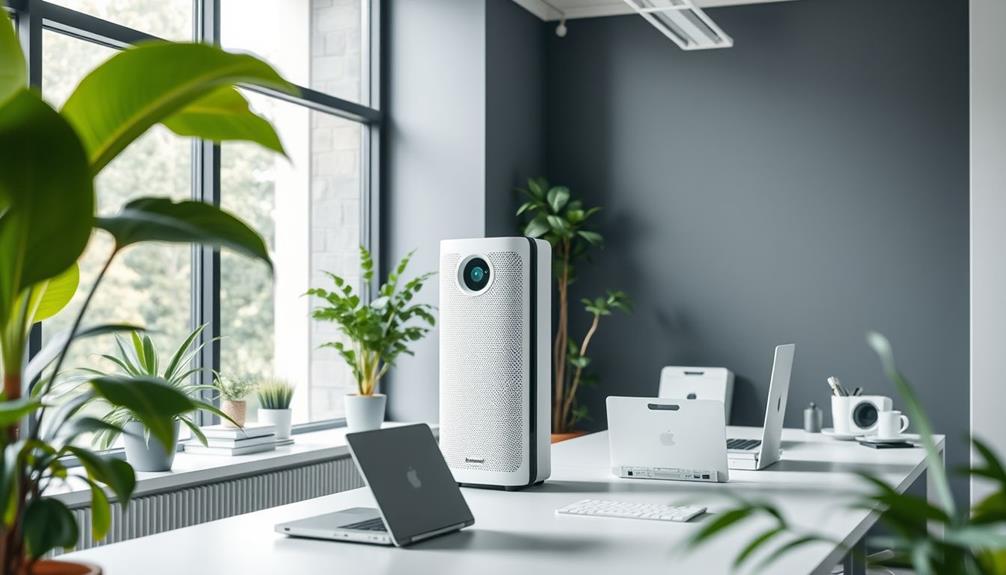
Choosing an air purifier for your office is essential for improving air quality and productivity. Start by measuring your workspace to select a unit with a Clean Air Delivery Rate (CADR) suitable for that size. Look for HEPA filters to capture allergens and activated carbon filters for odors. Make sure the noise level stays below 50 decibels to maintain a conducive environment. Remember that regular maintenance and filter replacement are key for peak performance. Combining your air purifier with proper ventilation will enhance results further. Want to explore more about selecting the perfect purifier? There's a lot more to reflect on!
Key Takeaways
- Measure your office space to select an air purifier with a CADR rating that matches at least two-thirds of the square footage.
- Choose air purifiers with HEPA filters for allergens and activated carbon filters for VOCs and odors to address specific air quality concerns.
- Ensure the air purifier operates at or below 50 decibels to maintain a comfortable work environment without distractions.
- Regularly replace filters and assess maintenance needs to ensure the air purifier operates efficiently and effectively.
- Integrate air purifiers with proper ventilation systems to meet air exchange guidelines and enhance overall air quality.
Importance of Air Quality
Air quality plays an essential role in your overall well-being, especially in office environments. Poor indoor air quality can lead to respiratory illnesses, fatigue, and decreased productivity. In fact, 57% of offices report symptoms linked to sick building syndrome, which can markedly impact your day-to-day work life.
When air quality improves, you can experience a productivity boost of up to $6,500 per person annually. Utilizing ozone air purifiers can effectively eliminate allergens and odors, further enhancing the workspace atmosphere.
Clean air not only enhances concentration but also supports better work efficiency and overall job satisfaction. By maintaining good air quality, you can reduce sick days by as much as 35%, which ultimately contributes to a healthier workforce.
When you invest in an air purifier, you're taking a proactive step towards creating a conducive office space that fosters employee performance. Good air quality leads to a more comfortable work environment, allowing you and your colleagues to thrive.
Benefits of Air Purifiers
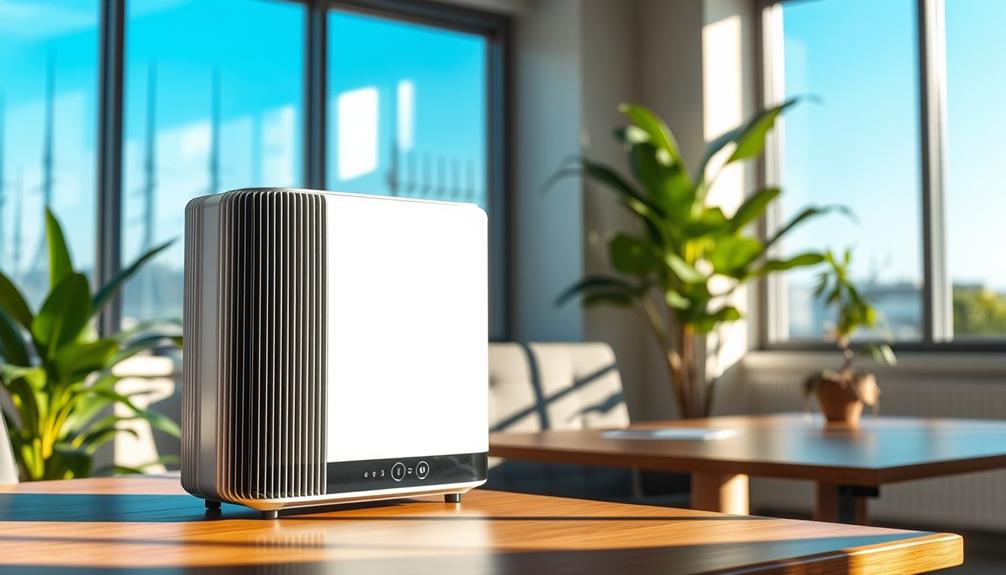
Investing in air purifiers offers numerous advantages that directly impact your workplace environment. Air purifiers include advanced technology like particulate air (HEPA) filters that effectively remove airborne particles, including PM2.5, VOCs, and even bacteria and viruses.
By improving air purification, you can greatly enhance indoor air quality, reducing pollutants linked to respiratory issues and sick building syndrome, which affects 57% of offices. Moreover, a holistic lifestyle approach, such as incorporating regular physical activity, can additionally support overall well-being in the workplace, leading to improved health outcomes mindful eating practices.
The benefits don't stop there. Research shows that better air quality can boost workplace productivity by up to $6,500 per person annually. Additionally, installing air purifiers can decrease sick days by 35%, minimizing illness-related absences among your team.
With cleaner air, employees often experience greater satisfaction and comfort, fostering a more conducive work environment.
As you create an office that prioritizes health and well-being, you're not just enhancing productivity but also nurturing a happier workforce.
To conclude, investing in air purifiers can transform your workspace into a healthier, more productive haven, benefiting both your employees and your organization as a whole.
How Air Purifiers Work

Air purifiers use various filtration mechanisms to clean the air in your space.
For instance, they can help create a serene atmosphere similar to what you might find in a modern farmhouse bedroom by removing allergens and pollutants.
You'll find that mechanical filters like HEPA capture tiny particles, while activated carbon filters tackle odors and VOCs.
Understanding these technologies and the factors affecting their performance can help you choose the right purifier for your needs.
Filtration Mechanisms Explained
When it comes to improving indoor air quality, understanding how air purifiers work is essential. Air purifiers operate by using a fan to draw in contaminated air, which then passes through various filters designed to capture specific pollutants.
One of the most effective options is HEPA filters, which trap 99.97% of particles that are 0.3 microns or larger, making them great for removing allergens like pollen and pet dander. Additionally, just as home security systems can enhance safety, ensuring clean air in your workspace promotes overall well-being and productivity enhancing overall well-being.
Activated carbon filters play a vital role as well; they absorb volatile organic compounds (VOCs) and odors, targeting gases that mechanical filters can't capture.
For an added layer of air hygiene, UV filters use ultraviolet light to kill airborne microorganisms such as bacteria and viruses when paired with particulate filters.
While ozone generators can oxidize pollutants to remove odors and smoke, use them cautiously, as inhaling ozone can pose health risks.
Performance Variability Factors
Numerous factors can impact how effectively your air purifier works in improving indoor air quality. The Clean Air Delivery Rate (CADR) is a key metric to evaluate; it measures how quickly the air purifier can filter pollutants from the air. For an office air purifier, a higher CADR rating means better performance, especially in larger spaces.
Similar to how a self-cleaning mechanism in vacuums reduces maintenance needs, efficient air purifiers can help minimize upkeep by maintaining ideal performance.
Different filters play a essential role in air purifier uses. HEPA filters target airborne particles, activated carbon filters tackle odors and gases, while UV filters can eliminate bacteria and viruses. The type of pollutants you're dealing with will determine which filters you need.
Additionally, the size of the room and the height of the ceilings affect how well the air purifier can circulate clean air.
Regular filter replacement is critical; clogged or dirty filters can greatly reduce your unit's efficiency, leading to poor air quality.
Key Features to Consider

Selecting the right air purifier can greatly enhance your indoor air quality, fostering a healthier workspace. When evaluating office air purifiers, start with the Clean Air Delivery Rate (CADR) rating. Aim for a CADR that's at least two-thirds of your room's square footage to guarantee adequate air cleaning performance.
Additionally, consider how air purifiers can contribute to a cleaner environment, similar to the key factors in choosing a home cleaning service, as both focus on improving overall cleanliness and health.
Next, consider the filter type. HEPA filters are essential for capturing allergens and fine particles, while activated carbon filters help eliminate gases and odors commonly found in office settings.
Don't overlook noise levels; choose models with noise levels below 50 decibels to maintain a productive work environment without distractions.
Energy efficiency is another key feature. Look for ENERGY STAR certified models, which are at least 27% more energy-efficient than standard options, lowering both operational costs and your environmental footprint.
Lastly, think about size and placement. Confirm the air purifier is appropriately sized for your office space, taking into account both floor area and ceiling height, to maximize airflow and purification effectiveness.
Steps to Choose an Air Purifier
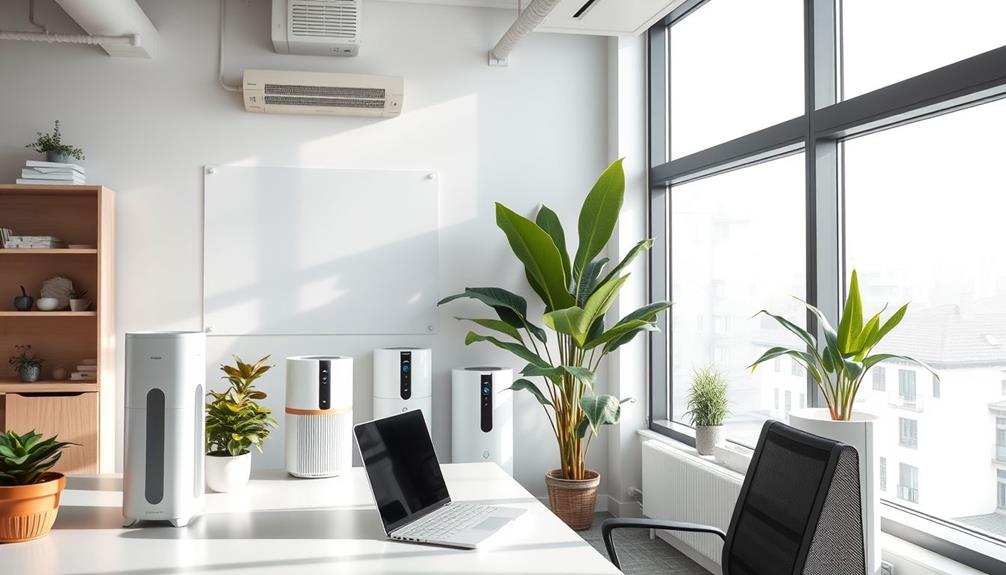
Choosing the right air purifier involves a few straightforward steps that guarantee you get the most suitable model for your office needs.
Start by measuring your office space's square footage and volume. This will help you choose a purifier that can handle at least double the calculated volume for effective air exchange.
Additionally, consider how environmental factors, such as proper disposal practices, might affect your office air quality, especially if there are sources of pollutants nearby.
Next, review the Clean Air Delivery Rate (CADR) ratings. Aim for a unit with a CADR that matches your office size; higher ratings assure better performance in removing dust, smoke, and pollen.
Consider the type of filters your air purifier will use. HEPA filters are essential for trapping allergens, while activated carbon filters effectively eliminate odors and gases.
Make certain the chosen model addresses your specific air quality concerns.
Don't forget to evaluate the noise levels. Choose models that operate at or below 50 dB to minimize distractions.
Limitations of Air Purifiers
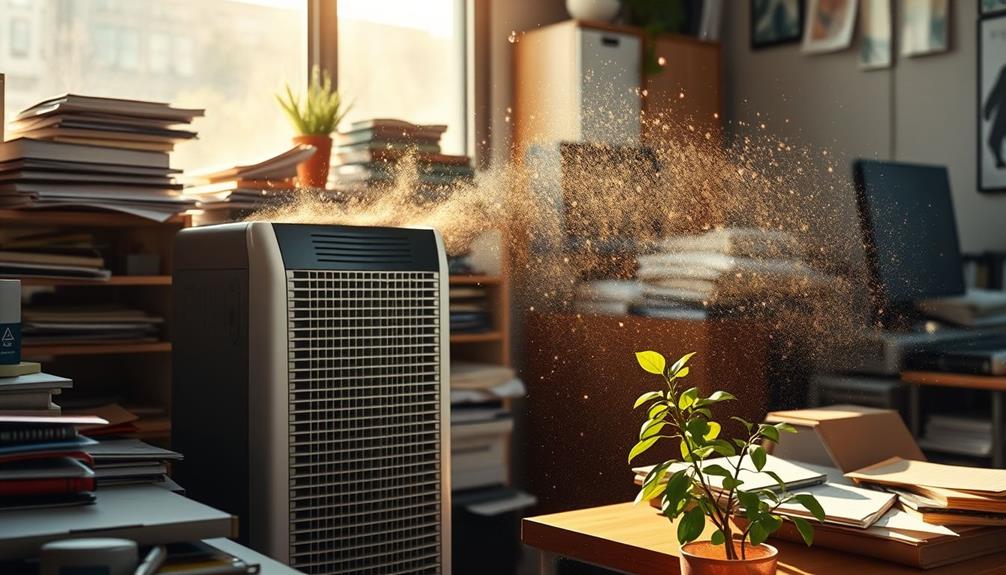
While air purifiers can improve indoor air quality, they can't replace proper ventilation, so stale air can still linger.
Additionally, neglecting HVAC maintenance can lead to compromised air quality, making it essential to guarantee your heating and cooling systems are in good shape importance of HVAC maintenance.
They also lack the ability to detect air quality issues, meaning you might need additional tools to monitor your environment.
Plus, if you're dealing with specific gases, you'll need filters designed for that purpose to guarantee effectiveness.
Cannot Replace Ventilation
Air purifiers have their place in improving indoor air quality, but they can't replace the essential role of ventilation. While purifiers can help reduce pollutants, they don't introduce fresh air into your workspace. This means that without proper ventilation, stale air can linger and pollutants may accumulate, diminishing the effectiveness of your purifiers.
For example, understanding the return policies for electronics can help you make informed decisions about purchasing devices to enhance your office environment. ASHRAE recommends that air replacement occurs at least twice per hour to maintain efficient air circulation and pollutant removal. Relying solely on air purifiers won't meet this guideline, as they can't achieve the necessary air exchange rates.
Furthermore, since purifiers lack independent detection capabilities, you won't know when additional ventilation is needed.
For the best indoor air quality, integrate purifiers with a proper ventilation system. This combination guarantees that not only are you removing particles and allergens, but you're also continuously bringing in clean air.
Limited Detection Capabilities
Even with air purifiers in place, you can't rely solely on them to manage your indoor air quality effectively. These devices have limited detection capabilities, meaning they can't identify air quality issues on their own.
When choosing an office air purifier, you need to know that without additional monitoring tools, you might miss critical pollutants. A purifier can clean the air quickly, but its effectiveness varies based on the type of contaminants present. Regular updates to your air quality strategy can enhance overall efficiency, as stated in strategies for increasing topical authority.
Moreover, air purifiers can be ineffective in environments with high gas runoff unless they're equipped with the right filters. This limitation underscores the importance of not solely depending on them for indoor air quality.
You should look for when choosing an air purifier that it complements your existing ventilation system, as stale air will persist without proper airflow.
To achieve ideal results, it's wise to purchase an air purifier alongside Indoor Air Quality (IAQ) monitors. This combination guarantees that you effectively tackle diverse air quality challenges while maximizing the benefits of your air purifier.
Specific Filter Requirements
Choosing the right air purifier involves understanding specific filter requirements, as not all filters are created equal.
While air purifiers can help reduce pollutants, they can't solve all indoor air quality issues on their own. To guarantee you're choosing the best option, consider the following:
- High-Efficiency Particulate Air (HEPA) Filters: Ideal for trapping small particles like dust and allergens.
- Activated Carbon Filters: Effective at removing odors and volatile organic compounds (VOCs).
- Pre-filters: Capture larger particles, extending the life of the main filter.
- UV-C Light: Some models offer UV-C technology to kill bacteria and viruses.
- Gas Emission Compatibility: Confirm the purifier is suited for environments with high gas emissions.
Conclusion
To sum up, investing in an air purifier for your office can greatly enhance your workspace's air quality, leading to better health and productivity. For instance, a company in a busy urban area noticed a 30% decrease in employee sick days after installing high-efficiency particulate air (HEPA) purifiers. By choosing the right model and considering key features, you can create a cleaner, healthier environment that benefits everyone. Don't underestimate the power of fresh air in your daily work life!
In the dynamic world of air purifiers and clean air advocacy, Aire stands out as a beacon of knowledge and passion. As the Editor in Chief of Aero Guardians, Aire has been instrumental in shaping the platform’s voice and direction, ensuring that every piece of content resonates with clarity, authority, and authenticity.
-

 FAQs - Advanced Queries3 months ago
FAQs - Advanced Queries3 months agoWhat Do the Numbers on My Air Purifier Mean
-

 Air Purifier Guides6 months ago
Air Purifier Guides6 months agoHow to Reset Filter on Miko Air Purifier
-

 Types of Air Purifiers7 months ago
Types of Air Purifiers7 months agoWhat Is an Air Purifier
-

 Air Purifier Guides3 months ago
Air Purifier Guides3 months agoHow to Make a Homemade Ozone Generator (Air Purifier
-

 Vetted5 months ago
Vetted5 months agoAera Mini Review: Smart Home Fragrance Diffuser With Hypoallergenic Scent Technology (2023)
-

 Maintenance and Tips8 months ago
Maintenance and Tips8 months agoHow to Reset Filter Light on Winix Plasmawave Air Purifier
-

 Air Purifier Guides8 months ago
Air Purifier Guides8 months agoHow to Dispose of Air Purifier Filter Levoit
-

 FAQs - Advanced Queries8 months ago
FAQs - Advanced Queries8 months agoWhen to Use Ionizer on Coway Air Purifier





